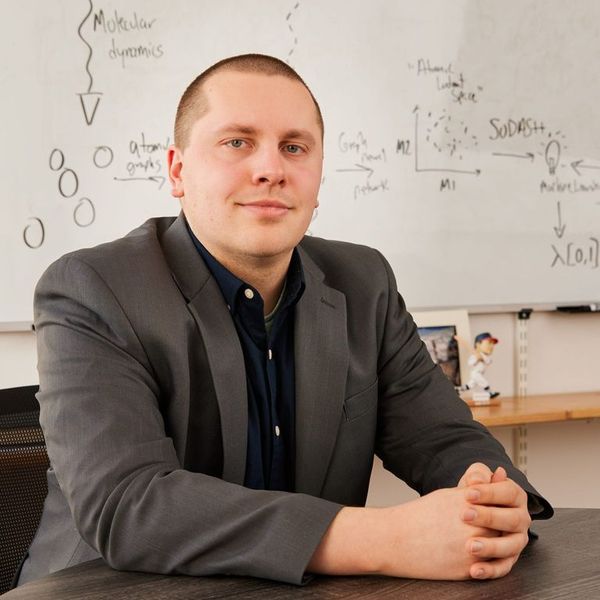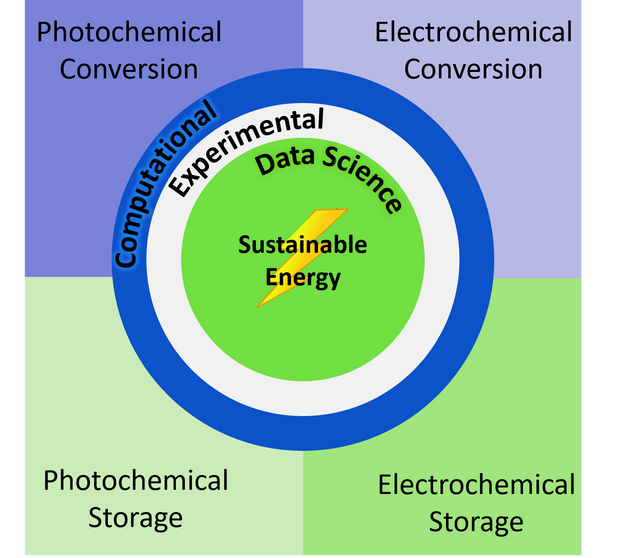Advancing Sustainability Through AI-driven Research and ENERGIZE Graduate Training
Junior Faculty Fellow Spotlight: James Chapman, Assistant Professor, Mechanical 工程
High-entropy alloys (HEAs) have major applications to the world of materials science. These alloys contain roughly equal amounts of five or more different elements with different crystal structures, which allows the materials to have increased strength, hardness, wear resistance, thermal stability, and corrosion resistance. They also prove to be better conductors for heat and electricity, and have improved magnetic properties compared to other alloys. HEAs have applications in jet engines due to their thermal stability, automobile suspension systems and drivetrain components due to their high strength, and orthopedic implants due to their corrosion resistance and biocompatibility, among other uses.

James Chapman, Hariri Institute faculty fellow and assistant professor of mechanical engineering, leads the Materials Informatics Lab at Boston University College of 工程, which focuses on the fusion of data science with materials science to discover and design next-generation materials for energy generation and storage, corrosion resistance, and pollution mitigation. Tools such as quantum mechanics, multi-scale simulations, and machine learning are harnessed to better understand how materials behave under extreme conditions.
Chapman has been using machine learning algorithms to create simulations which can rapidly predict important properties of newly discovered materials. Chapman ultimately seeks to discover novel HEAs to produce hydrogen and limit pollution. The Hariri Institute awarded Chapman a 2024 Junior Faculty Fellowship to support his work.
Ch
A collaboration with Lawrence Livermore National Laboratory also resulted in a paper titled “Score-based denoising for atomic structure identification” published in npj Computational Materials. This work focused on using denoising techniques to remove structural noise from atomistic simulations, providing insight into the underlying structure in a more interpretable way.
In addition to his research, Chapman is Co-PI on the $3 Million NSF ENERGIZE NRT grant, which will provide opportunities for graduate students to address key scientific challenges in developing materials for sustainable energy, through convergent research.
The Hariri Institute asked Chapman about his current research, work on ENERGIZE, and future opportunities as a Hariri Institute Junior Faculty Fellow.
Hariri Institute: Can you describe your research focus and its applications?
Chapman: My current research focuses on the fusion of data science/machine learning with physics-based atomistic simulations to discover and design new materials. We are particularly interested in new high entropy materials, metal organic frameworks, and liquid metals for catalytic, energy storage, corrosion, and chemical warfare applications. We have made progress in creating models and algorithms to identify new materials within physically interpretable latent spaces, and building machine learning models that can rapidly predict important materials properties like stability, elastic moduli, and atomic-scale disorder.
Hariri Institute: How did you become interested in this? Was there something that inspired this area of interest?
Chapman: I have always been interested in atomic-scale phenomena. As an undergraduate researcher I realized how computations could be used to better understand how this regime behaves without needing to perform experiments. Now, I realize that the true power of computations is combining abundant simulated data and experimental observations to build accurate and robust models that neither paradigm could construct on their own.
Hariri Institute: What are the main goals or objectives of your research?
Chapman: The main long-term objective is designing a framework that can rapidly discover new materials for a targeted application and then spawn complex simulations to understand how to tailor the best materials for those applications (how to synthesize them, how they fail, etc). Our short-term goals consist of building models to predict the stability of materials like high entropy alloys and metal organic frameworks, and creating a system that can autonomously perform and characterize atomistic simulations.
Hariri Institute: Has there been a recent development or finding that you find particularly exciting?
Chapman: We’ve recently been able to map “global” information, such as temperature, onto local atomic environments during atomistic simulations through our graph neural network scheme SODAS. More specifically, we have accomplished this for materials with 6 elements. This is a major accomplishment because current characterization schemes struggle to capture things like atomic disorder for materials with many elements. SODAS can do this with very little reference data and performs the mapping process autonomously, making the algorithm universal to any material system.
Hariri Institute: Can you tell us about the work you are doing on ENERGIZE?

Chapman: On ENERGIZE, my work involves developing curriculum with the aim of bridging the current knowledge gaps between data science and AI, and physical science and engineering disciplines such as chemistry, physics, and materials engineering. The last two decades have seen a rise in the use of data science and AI in many fields, but the integration of these techniques into the physical sciences and engineering has been challenging due to the unique circumstances of problems in these fields.
Issues such as limited and multi-model data, noisy measurements, and a lack of interpretability in model predictions have driven a gap between data scientists and physical scientists and engineers. Through ENERGIZE, we aim to bridge this gap and equip a new generation of scientists and engineers with the data science tools to solve the most challenging materials science problems of our age.
Hariri Institute: What do you feel is most rewarding about your work – either as a professor or researcher?
Chapman: The most rewarding part of my work is easily watching students accomplish things, either in an education or research setting. Providing the mentorship and guidance and watching students figure things out and be proud of their accomplishments makes this the best job in the world.
Hariri Institute: How do you plan on using this fellowship opportunity?
Chapman: I would like to engage with Hariri more, in both community and grant aspects. Grant-wise, Hariri has an excellent grant staff that I think can help me with my future grant proposals. Community-wise, I’m interested in getting involved to both expand my professional network and potentially spark fruitful collaborations.
The Hariri Institute’s Junior Faculty Fellowship recognizes early-career researchers at BU and supports their development through internal networking between fellows and the wider Hariri Institute community.
Learn more about current Junior Faculty Fellows and the program here.